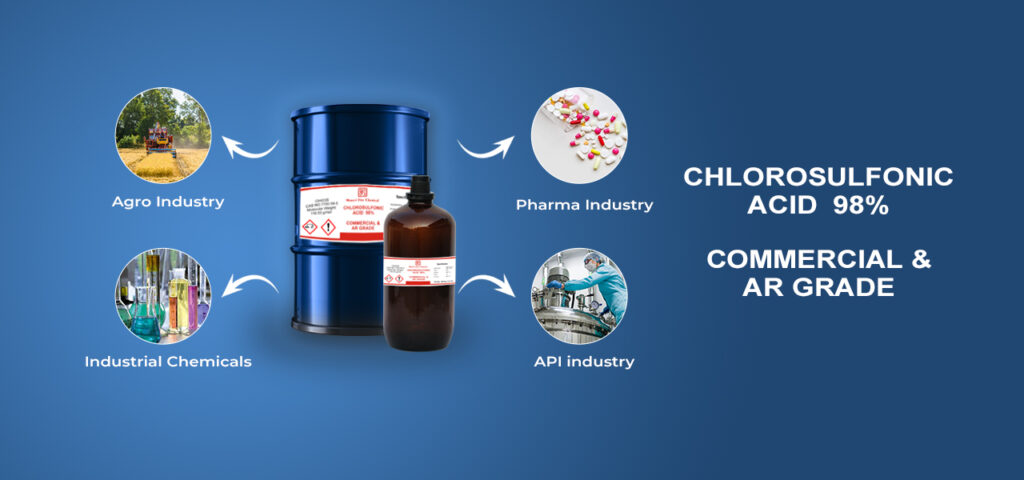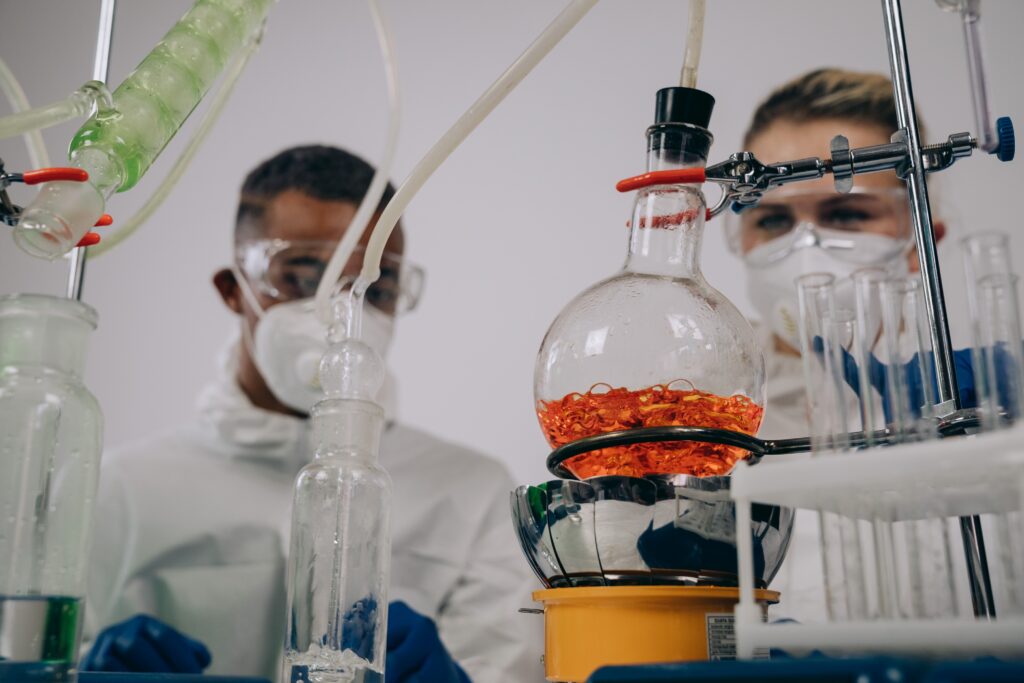Fuming nitric acid is a highly corrosive and powerful oxidizing agent that finds extensive use in various industries. Its production and applications play a crucial role in the development of key sectors, including manufacturing, chemical processing, and research. In this blog, we will explore the production process of fuming nitric acid in Hyderabad, Bangalore, Gujarat, Mumbai, four major industrial cities in India.
Properties of Fuming Nitric Acid:
1 Corrosive Nature:
Fuming nitric acid is an extremely corrosive compound that can cause severe damage to skin, eyes, and respiratory system upon contact.
2 Strong Oxidizing Agent:
It is a potent oxidizing agent, meaning it has the ability to react violently with flammable materials, increasing the risk of fire or explosions.
3 High Toxicity:
Inhalation or ingestion of fumes or droplets of fuming nitric acid can lead to serious health effects, including respiratory distress and internal organ damage.
4 Reactivity:
Fuming nitric acid reacts vigorously with a wide range of organic and inorganic compounds, which increases the potential for unexpected chemical reactions and releases of toxic gases.
Hazards of Fuming Nitric Acid.
5 Health Risks:
Exposure to fuming nitric acid can cause severe burns, skin and eye irritation, respiratory problems, and long-term health issues. It may lead to the formation of toxic nitrogen dioxide gas upon contact with moisture, exacerbating the risks.
6 Fire and Explosion Hazards:
Fuming nitric acid is highly reactive and can ignite flammable substances, leading to fire or explosions. It intensifies the combustion of combustible materials and can trigger spontaneous ignition under certain conditions.
Environmental Impact: Improper handling, storage, or disposal of fuming nitric acid can result in environmental contamination, causing harm to aquatic life, vegetation, and soil.
Hyderabad:
Hyderabad, the capital of Telangana and a major hub for the pharmaceutical and chemical industries, utilizes fuming nitric acid in Hyderabad various applications. Pharmaceutical companies often employ fuming nitric acid for the synthesis of active pharmaceutical ingredients (APIs), as well as for the production of specialty chemicals used in drug formulations. Additionally, Hyderabad’s chemical manufacturing sector extensively uses fuming nitric acid in the production of dyes, pigments, and intermediates.
Bangalore:
Known as the “Silicon Valley of India,” Bangalore boasts a thriving technology industry. Fuming nitric acid in banglore finds application in the manufacturing of electronic components and semiconductors in the city. Its strong oxidizing properties make it suitable for etching printed circuit boards (PCBs) and cleaning electronic devices. Bangalore’s research and development institutions also utilize fuming nitric acid in various chemical experiments and laboratory processes.
Gujarat:
Gujarat, one of the most industrialized states in India, hosts a wide range of chemical manufacturing units. Fuming nitric acid in Gujrat is a vital ingredient in the production of fertilizers, including ammonium nitrate, which is widely used in agriculture. The state’s textile industry also employs fuming nitric acid for dyeing and printing textiles. Additionally, Gujarat’s chemical and petrochemical sectors rely on fuming nitric acid for the synthesis of organic compounds and polymers.
Mumbai:
Mumbai, the financial capital of India, houses a diverse industrial landscape. Fuming nitric acid is extensively used in Mumbai’s metal processing and metallurgy industries for metal cleaning, pickling, and surface treatment. The city’s jewelry industry relies on fuming nitric acid in Mumbai for the purification and etching of precious metals. Mumbai’s research institutions and educational centers also utilize fuming nitric acid in chemical experiments and analytical procedures.
Safety Measures Fuming Nitric Acid in Hyderabad, Bangalore, Gujarat, and Mumbai:
1 Storage and Transportation:
Fuming nitric acid must be stored in dedicated containers made of compatible materials, such as high-density polyethylene (HDPE) or specialized corrosion-resistant metals. These containers should be kept in well-ventilated areas, away from flammable materials and sources of heat. During transportation, strict adherence to safety protocols, such as using approved tankers and following hazardous material transportation regulations, is essential.
2 Handling and Personal Protective Equipment (PPE):
Workers involved in the handling of fuming nitric acid must wear appropriate PPE, including gloves, safety goggles, face shields, and protective clothing. Proper training and knowledge of handling techniques are crucial to minimize the risks associated with this hazardous chemical.
3 Emergency Response:
Adequate emergency response plans should be in place, including spill control measures, evacuation procedures, and immediate medical assistance. Employers and workers must be trained on emergency protocols to ensure quick and efficient responses in case of accidents or spills.
4 Regulatory Compliance:
The storage, handling, and transportation of fuming nitric acid are regulated by various government bodies, such as the Pollution Control Boards and the Ministry of Environment, Forest and Climate Change. These regulations cover aspects like licensing, record-keeping, waste management, and disposal procedures.
5 Proper Storage:
Fuming nitric acid should be stored in dedicated, well-ventilated areas with secure containers made of compatible materials. These storage facilities should be equipped with appropriate labeling, fire suppression systems, and spill containment measures.
Personal Protective Equipment (PPE):
Workers involved in handling fuming nitric acid must wear suitable protective clothing, including chemical-resistant gloves, goggles, face shields, and respiratory protection, to minimize the risk of exposure.
1 Training and Education:
Employees handling fuming nitric acid should receive comprehensive training on its properties, safe handling practices, emergency procedures, and first aid measures. Regular refresher courses are crucial to ensure awareness and competence.
2 Ventilation Systems:
Adequate ventilation systems should be in place to control and remove hazardous fumes and prevent their accumulation in the working environment.
3 Emergency Preparedness:
Emergency response plans, including spill control measures, evacuation procedures, and access to emergency showers and eyewash stations, should be established and communicated to all personnel.
4 Regulatory Compliance:
Strict adherence to local, state, and national regulations governing the handling, transportation, and disposal of fuming nitric acid is vital to minimize risks and ensure the safety of workers and the public.
Conclusion:
Fuming nitric acid poses significant hazards due to its corrosive nature, strong oxidizing properties, and toxicity. Cities like Hyderabad, Bangalore, Gujarat, and Mumbai recognize the importance of implementing robust safety measures to mitigate these risks. Strict adherence to proper storage, handling procedures, personal protective equipment usage, and regulatory compliance is crucial to ensure the safe management of fuming nitric acid and protect the well-being of individuals and the environment.



